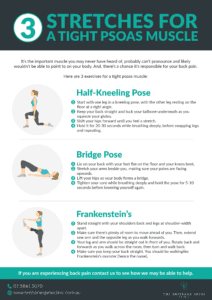It’s an important muscle you may never have heard of, probably can’t pronounce and likely wouldn’t be able to point to on your body.
And, there’s a chance it’s responsible for your back pain.
The psoas (pronounced SO-as) major is a long muscle located in your lower back. It’s one of three muscles that connects your spine with your legs, and it’s responsible for how you hold yourself and a lot of your movements. Unfortunately, it can also be responsible for some discomfort if you’re not looking after it.
How does it cause back pain?
Estimates show that a whopping 70-90 percent of Australians will experience lower back pain at some point in our lives. Our lifestyles are partly to blame, with nearly 70 percent of us living either sedentary lives or having low levels of physical activity.
That’s a whole lot of muscles that aren’t getting exercised properly.
As with all muscles, the psoas muscle needs to be moved to function at its best. If you’re not doing that, expect it to tighten and shorten – leading to back pain and poor posture. Psoas tightness is particularly common in people who sit at a desk all day and don’t do regular stretching exercises.
Your psoas muscle is known as the fight or flight muscle as it contracts when you’re under stress. This evolutionary throwback was originally designed to help us shrink our bodies to hide from potential threats.
What are the signs of a tight psoas muscle?
There are a number of signs that your psoas muscle is too tight. These include:
- Tension and pain in the lower back, hips, buttocks, pelvis, or groin
- Lower back spasms
- Radiating pain down the leg
- Your legs being different lengths
- Instability in the core of the body
- Limited flexibility in the lower back
How do I treat it?
There’s a range of treatments available to help you manage a tight psoas muscle. If you find yourself with any of the symptoms above, it’s worth consulting with a physiotherapist or spinal specialist to get some advice on a plan that works for you.
If you’re keen to start some stretches to help work your psoas muscle and release tension, here’s a few recommended by our team of spinal specialists.
Half-Kneeling Pose
Start with one leg in a kneeling pose, with the other leg resting on the floor at a right angle. Keep your back straight and tuck your tailbone underneath as you squeeze your glutes. Shift your hips forward until you feel a stretch. Hold it for 20-30 seconds while breathing deeply, before swapping legs and repeating.
Bridge pose
Lie on your back with your feet flat on the floor and your knees bent. Stretch your arms beside you, making sure your palms are facing upwards. Lift your hips so your body forms a bridge. Tighten your core while breathing deeply and hold the pose for 5-10 seconds before lowering yourself again.
Frankensteins
Stand straight with your shoulders back and legs at shoulder-width apart. Make sure there’s plenty of room to move ahead of you. Then, extend one arm and the opposite leg as you walk forwards. Your leg and arm should be straight out in front of you. Rotate back and forwards as you walk across the room, then turn and walk back. Make sure you keep your back straight. You should be walking like Frankenstein’s monster (hence the name).

“Psoas muscle dysfunction is a perfect example of structures that can disguise itself as disc bulge and sciatic nerve pain. Our philosophy is always about diagnosing the most accurate cause of your back pain and sciatica. These exercises can be helpful as a preliminary measure to target psoas muscle issues, if symptoms persist, please seek professional help.” Ms Jiaming (Caroline) Sui, Women’s Health and Musculoskeletal Consultant of The Brisbane Spine Clinic.
When do I need professional help?
If you’re experiencing back pain or are concerned about how to keep your psoas muscle in tip-top shape, talking to a spinal specialist or physiotherapist is your best course of action.
If you’re looking for an Eight Mile Plains or North Lakes physiotherapist who specialises in spinal treatment and back pain, call us to discover The Brisbane Spine Clinic difference. You can book an appointment with Ms Jiaming (Caroline) Sui to learn more today.







